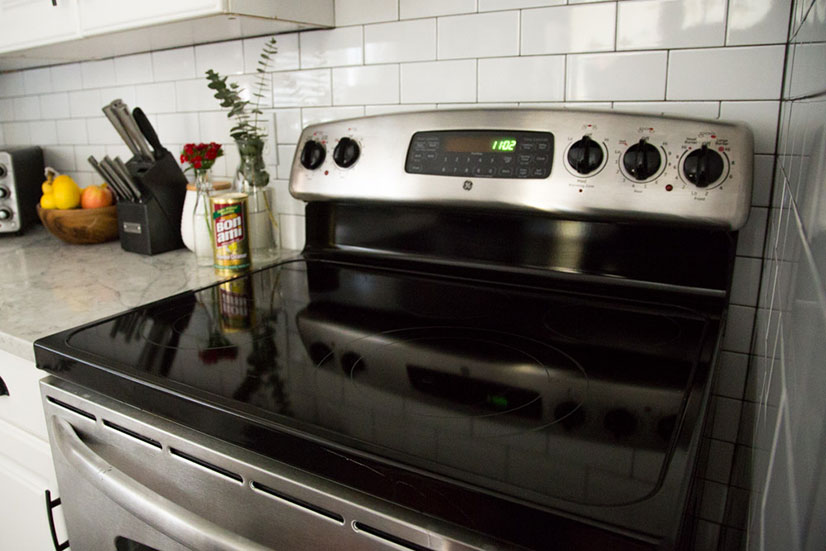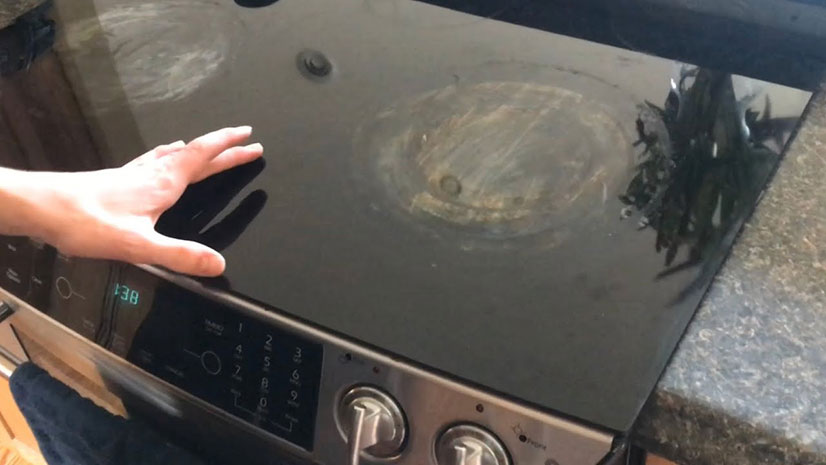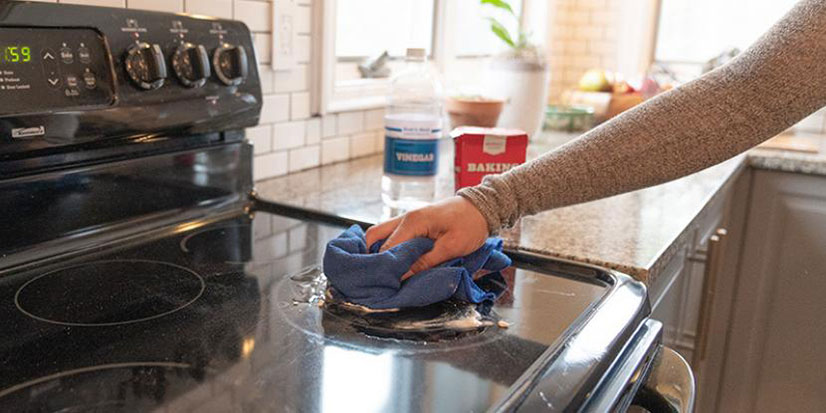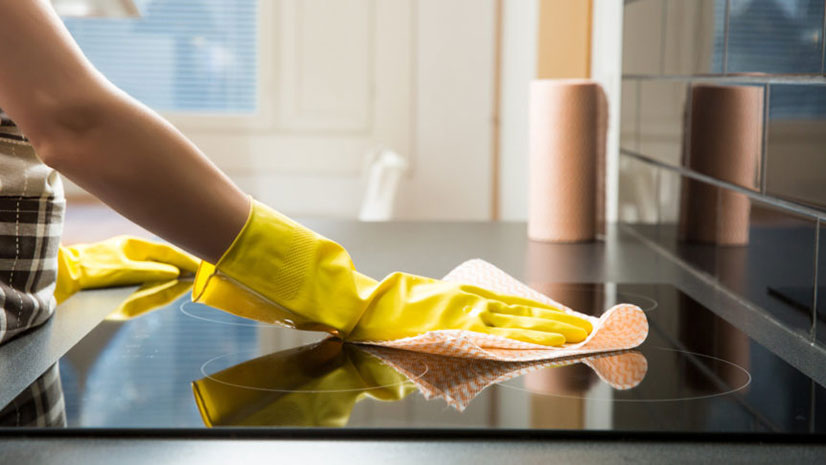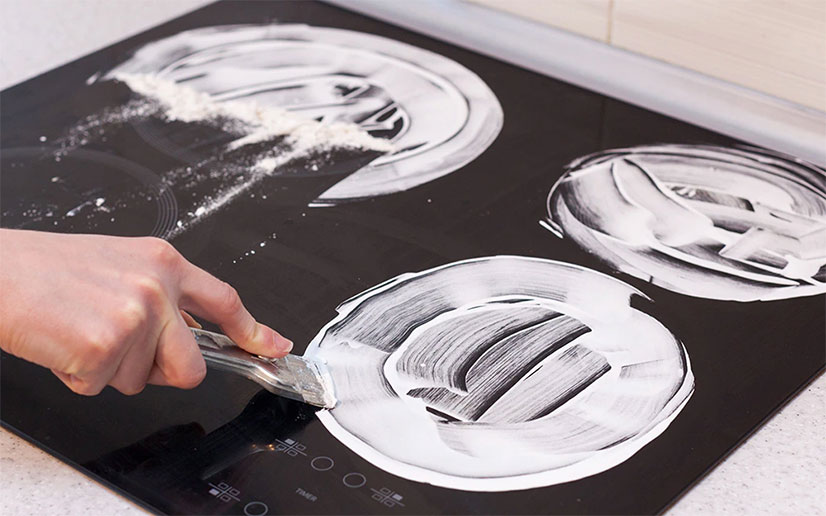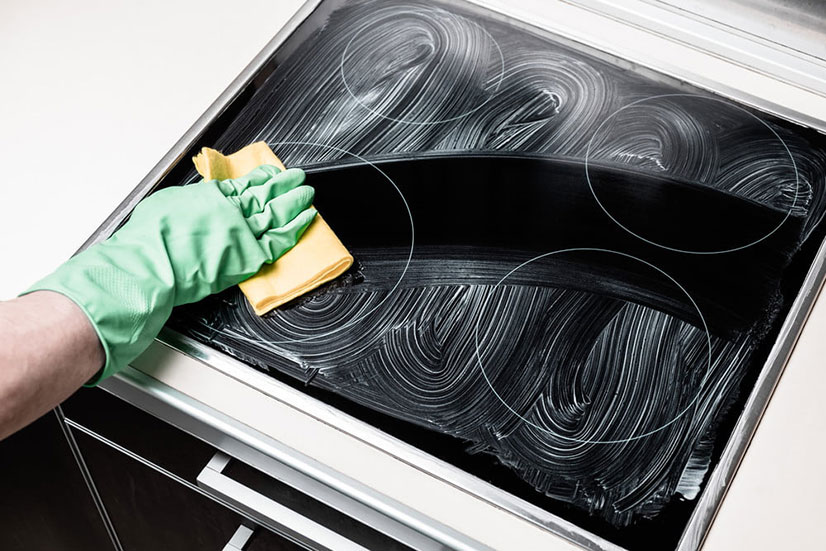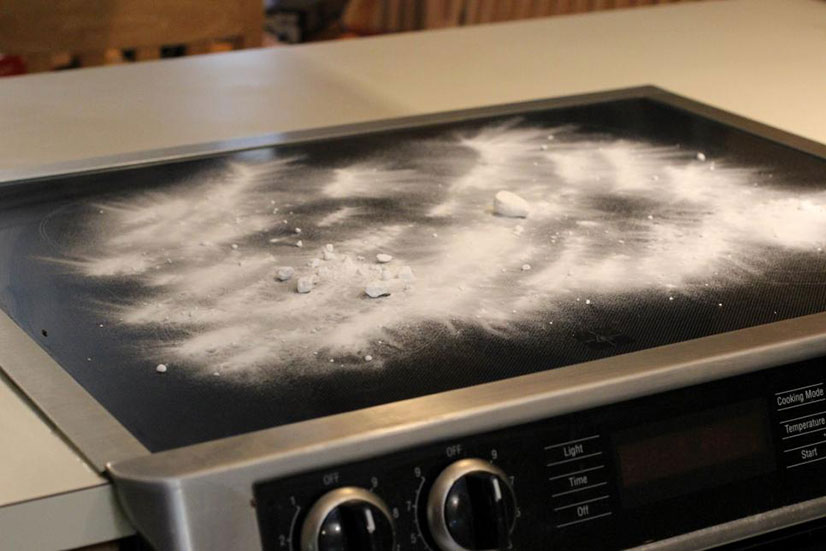Glass top stoves look beautiful when they’re first installed, but keeping them clean can be a chore. What’s the best way to clean the glass without scratching the surface? How do you remove burnt-on food? And how can you prevent your glass stove top from discoloring? In this post, we’ll share some Pro tips on how to keep your glass stove top sparkling clean, no matter what is spilled on it!
How to clean a glass top stove burner
Regular cleaning goes a long way to preventing residue buildups that look unsightly, and can increase the risk of burning. Wipe down the glass after each use. Always do this when the glass is cool to prevent burns or damage to the stove top. Cleaning your glass stove top while it’s still hot can cause damage to the glass.
Related: These simple habits help keep your home clean
Once a week, give your stove top glass a little extra TLC. Use a cleaner designed for the job, or make a DIY version using one of the recipes below. Apply the cleaner and wait 10 minutes (or follow the instructions on the bottle) before wiping off. Use a microfiber cloth to dry and buff the stove top glass to keep it gleaming.
Avoid scrubbing brushing, scouring pads, Magic Erasers, or other abrasive cleaning equipment, because these can scratch the glass. Stick with a microfiber cloth or a soft sponge. And don’t put too much elbow grease into the task. Pressure can crack the glass. Instead, if a stain won’t come loose, try one of the cleaning methods outlined below to lift it gently without causing damage.
GLASS STOVE STAIN TYPE |
CLEANING SOLUTION |
Water stains / boiled over pans |
White vinegar |
Spilled food |
Vinegar and baking soda |
Old cleaner residue |
Vinegar and baking soda |
Mineral deposits |
Dish soap, baking soda, and citric acid |
Micro scratches from cookware |
Dish soap, baking soda, and citric acid |
How to clean a black glass top stove
Black glass stove tops often show stains and smears faster than other colors. However there are ways you can keep your black glass looking brand new all the time. As well as wiping down your stove top after use, and cleaning once a week, follow these tips for black glass.
- Dry wipe to remove dust before cleaning. This prevents the dust from getting stuck to the glass when it gets wet.
- Avoid soap and soap-based cleaners. Soap often leaves residue behind that will make your black glass look smeared. Instead use a cleaner designed for the job, or one that will cut through grease residue, such as white vinegar.
- Use microfiber cloths, not paper towels. The last thing you want on your black glass is traces of paper towel.
Black glass top stove discoloration
Unfortunately, even with the best care you might still notice your black glass stove top is starting to become discolored. Often the cause is something that got burnt onto the stove top, either food or the cleaner you use. Sometimes simple hard water stains are enough to discolor a black glass stove. To remove the stains, spray the cold stove top with white vinegar and clean as normal. The vinegar cuts through stains without causing damage to the glass.
Related: All about cleaning with vinegar
When the glass is clean, make sure to dry it thoroughly. This will prevent new water stains from forming. Then ensure you always use a cleaner designed for stove tops.
How to clean an electric glass stove top
Using liquid cleaners on an electric stove might make you nervous, but don’t worry. As long as water doesn’t run down the sides of the stove top and come into contact with the wiring at the back, your stove will be fine. Use a small amount of cleaning solution — either purchase a stove top cleaner or use a DIY solution such as vinegar and baking soda. You’ll only need around a tablespoon of liquid to start, and only add more if necessary. The cleaner will spread well across the glass surface, so you might be surprised how little you need. Dry the glass afterward with a microfiber cloth to remove any streaks and prevent water damage to the electrics.
How to clean stubborn stains on a glass cooktop
Some stains don’t respond to the first cleaning. This is especially true if you spill hot grease onto your glass cooktop, or use the wrong cleaner. Many commercial glass cleaners are designed for windows, and don’t react well to being heated. Avoid putting any harsh chemicals, bleach, or ammonia (or cleaning solutions containing those ingredients) on your glass cooktop, even when cold. Otherwise the next time you heat up your stove top, you might be in for an unpleasant surprise.
Instead, use a cleaning solution designed for cooktops. If the first attempt at cleaning doesn’t work, you may need to repeat it two or three times to completely remove a stain. Some stains, such as badly burnt on food, also need a little extra treatment.
How to clean a glass top stove with burnt on food
If a spill has set hard on your glass cooktop and cleaning solutions alone won’t lift it, it’s time to use a cleaning tool to remove it. One of the best tools to use is a handheld razor blade, or using a glass top stove cleaner scraper. Always take care when using a razor blade, both because you risk injury, and because it can scratch the glass. Always check the manufacturer’s instructions first to find out if you can use a razor on your glass — some glass has a treated surface that a blade will damage.
If the glass can be cleaned with a blade or scraper, first wet the surface of the stain with water or white vinegar and let it sit for 10 minutes. This will soften the stain, and the liquid provides important lubrication between the blade and the glass. Then hold the blade as flat to the surface of the stove top as possible and gently scrape the stain using a pushing motion. Don’t use the corners of the blade, as they will scratch the glass, and don’t be tempted to hold the blade upright, as this can also cause damage.
Once the stain has been removed, clean the stove top again as normal and all traces of the stain should be gone.
How to clean a glass top stove with burnt on plastic
One of the downsides of having a glass stove top is how easy it is to leave something on a hot burner by accident. Burning plastic onto your cooktop is a common mistake to make. Don’t worry, it can still be fixed. The first thing you should do is turn on the extractor fan, open a window, and leave the room until the stove and plastic have cooled. Burning plastic can release dangerous chemicals that you shouldn’t breathe in — and it smells awful!
If the plastic is thin, you can soften it up by pouring a little boiling water over it and leaving it for a few minutes. Then you should be able to remove it using your regular cleaning method. You can also use a razor blade or rubber scraper to gently lift it from the glass.
If there is a lot of plastic on the burner, or it has set very hard, use ice instead of boiling water. Freezing plastic will make it brittle, which makes it easier to remove. Work it loose using a wooden spoon and then clean as usual.
If the plastic still won’t shift, it’s time to use chemistry to break it down. WD-40 and nail polish remover (acetone) will both break down plastic, making it easier to clean. Only apply these solutions on a cold stove top, and use them sparingly just on the plastic. Let the plastic sit for 5-10 minutes and then scrape it loose. Once the plastic has been removed, clean the glass thoroughly.
How to remove cloudiness from a glass top stove
Several things can cause a glass stove top to become cloudy or hazy. Knowing the cause will help you treat it. If the cloudiness doesn’t respond to normal cleaning methods, it’s probably not a food or cleaning agent stain. Instead it could be mineral deposits from tap water, or even micro scratches from your pans or using the wrong cleaning tools. These can be removed if they aren’t too deep, but you’ll need something a little stronger than vinegar to do it.
You’ll Need
- Dishwashing liquid
- Baking soda
- Citric acid
First, apply the dishwashing liquid over the area you want to treat. Cover it with a layer of baking soda. Then make a mixture of 1 tablespoon citric acid and 1 cup of hot water. Put the mixture in a squirt bottle and squirt the baking soda and dishwashing liquid. Citric acid is stronger than vinegar, but don’t worry, it won’t burn you if you get it on your skin. Just wash it off with clean water.
Let the mixture bubble on the stove top for 20-30 minutes and then scrub it clean. Use a microfiber cloth and fresh water to remove all the residue, and then dry the glass. You can use a scrunched up newspaper to polish it if you like — newspapers won’t leave lint behind.
Related: Keep your granite countertops clean with these tips
DIY cleaning solutions for glass top stoves
Cleaning your glass stove doesn’t have to cost a fortune, or use any harsh chemicals. You can use ingredients already available at home.
How to clean a stove top with vinegar
- White vinegar
- Water
- Microfiber cloth
- Spray bottle
Mix one part vinegar with two parts water in a spray bottle. Spritz your stove top and clean with a microfiber cloth. The vinegar helps loosen stains and acts as a natural deodorizer.
How to clean a glass stove top with baking soda
- Baking soda
- Hot water
- Paper towels
- Microfiber cloth
Cover the stove top with a thin layer of baking soda. Then soak the paper towels (or a hand towel) in hot water. Wring out excess water and lie the towels on top of the baking soda. Leave for 15 minutes, then use the towels to gently clean the stain. Remove any residue with clean water using a microfiber cloth.
Using oven cleaner on a glass stove top
It might be tempting to use oven cleaner when you have a stubborn stain that won’t come off your glass stove, but don’t do it. Oven cleaners are too harsh and can damage the glass.
In conclusion
Cleaning a glass stove can be tricky, but not when you’ve got the Pros in your corner. A little routine cleaning — and the right solutions when you have a bigger spill on your hands — are all you really need.
